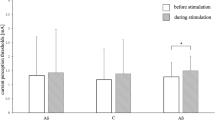Summary
Changes with temperature of maximum sensory nerve conduction velocity as well as absolute and relative refractory periods were tested in 14 human subjects. Corresponding to previously published findings maximum conduction velocity decreased with cooling following a Q10 of +1.4. The absolute and relative refractory periods were increased by cooling, the Q10 being −3.1 and −3.35 respectively. There was a tendency showing a more pronounced temperature effect at low temperatures. The Q10 and the steepness of the regressionline changed at the level of 26.9°C, but were significant for the relative refractory period only.
Zusammenfassung
An 14 gesunden jugendlichen Probanden wurde die sensible Nervenleitgeschwindigkeit sowie die absolute und relative Refraktärperiode des N. ulnaris bei Temperaturen zwischen 35°C und 20°C bestimmt.
Die Gewebstemperatur wurde durch eisgekühlte Gelkissen bis auf 20°C gesenkt und subkutan dicht am Nerven bestimmt.
Für die Bereiche 35°C bis 25°C und 30°C bis 20°C wurden die Q10-Werte für die sensible NLG mit 1,36 bzw. 1,44, für die absolute Refraktärperiode mit −3,18 bzw. −3,01 und für die relative Refraktärperiode mit −3,21 bzw. −3,49 bestimmt.
Die Unterschiede der Q10-Werte für die NLG und die Refraktärperioden sowie die Zunahme des Q10 unterhalb einer Temperatur von 27°C werden anhand der bisher veröffentlichten Literaturbefunde diskutiert.
Unter Berücksichtigung dieser Befunde ergibt sich bei Extrapolation klinisch-neurophysiologischer Meßwerte auf 35°C für die NLG eine Korrektur von 1,3 m/s pro °C und für die relative Refraktärperiode von 0,5 ms/°C.
Similar content being viewed by others
References
Angelakos, E. T.: Distribution of terminal temperatures in hypothermic dogs. Proc. Soc. exp. Biol. Med. N.Y. 97, 107 (1958)
Brooks, C. McC., Hoffmann, B. F., Suckling, E. E., Orias, O.: Excitability of the heart. New York: Grune & Stratton 1955
Burgen, A. S. V., Terroux, K. G.: The membrane resting and action potentials of the cat auricle. J. Physiol. 119, 139 (1953)
Buchthal, F., Rosenfalck, A.: Evoked action potentials and conduction velocity in human sensory nerves. Brain Res. 3, 1–122 (1966)
Buchthal, F., Rosenfalck, A.: Sensory potentials in polyneuropathy. Brain 94, 241–262 (1971)
Buchthal, F., Rosenfalck, A.: Sensory conduction from digit to palm and from palm to wrist in the carpal tunnel syndrome. J. Neurol. Neurosurg. Psychiat. 34, 243–252 (1971)
Carpendale, M. T. F.: Conduction time in the terminal portion of the motor fibers of the ulnar. median and peroneal nerves in healthy subjects and in patients with neuropathy. Thesis. University of Minnesota Graduate School (1956)
Coraboeuf, E., Weidmann, S.: Temperature effects on the electrical activity of the Purkinje fibres. Helv. physiol. pharmacol. Acta 12, 32 (1954)
Dawson, G. D.: The relative excitability and conduction velocity of sensory and motor nerve fibers in man. J. Physiol. (Lond.) 131, 436–451 (1956)
DeJesus, P. V., Hausmanowa-Petrusewicz, I., Barchi, R. L.: The effect of cold on nerve conduction of human slow and fast nerve fibers. Neurology 23, 1182–1189 (1973)
Edström, A., Hanson, M.: Temperature effects on fast axonal transport of proteins in vitro in frog sciatic nerves. Brain Res. 58, 345–354 (1973)
Frankenhaeuser, B., Huxley, A. F.: The action potential in the myelinated nerve fibre of Xenopus laevis as computed on the basis of voltage clamp data. J. Physiol. (Lond.) 171, 302–315 (1964)
Hegnauer, A. H., Angelakos, E. T.: Excitability properties of the hypothermic heart. Ann. N.Y. Acad. Sci. 80, 336 (1959)
Hirsch, H., Bange, F., Pulver, G., Steffens, J.: Evoked responses of the cat's visual cortex to optic tract stimulation at temperatures between 39° C and 15° C. EEG Clin. Neurophysiol. 12, 679 (1960)
Johnson, E. W., Olsen, K. J.: Clinical value of motor nerve conduction velocity determination. J. Amer. med. Ass. 172, 2030 (1960)
Koblet, H.: Physikalische Begriffe in der klinischen Biochemie, S. 135–141. Stuttgart: Thieme 1964
Lowitzsch, K., Hopf, H. C.: Refraktärperiode und Übermittlung frequenter Reizserien im gemischten peripheren Nerven des Menschen. J. Neurol. Sci. 17, 255–270 (1972)
Ludin, H. P., Beyeler, F.: Temperature dependence of normal sensory nerve action potentials. In press
McLeod, J. G.: Digital nerve conduction in the carpal tunnel syndrome after mechanical stimulation of the finger. J. Neurol. Neurosurg. Psychiat. 29, 12–22 (1966)
Paintal, A. S.: Effects of temperature on conduction in single vagal and saphenous myelinated nerve fibres of the cat. J. Physiol. (Lond.) 180, 20–49 (1965)
Paintal, A. S.: The influence of diameter of medullated nerve fibres of cats on the rising and falling phases of the spike and its recovery. J. Physiol. (Lond.) 184, 791–811 (1966)
Paintal, A. S.: Conduction in mammalian nerve fibres. In: New Developments in Electromyography and Clinical Neurophysiology, Vol. 2, pp. 19–41 (J. E. Desmedt, ed.). Basel: Karger 1973
Thauer, R., Brendel, W.: Hypothermie. Progr. Surg. Vol. 2, pp. 73–271. Basel-New York: Karger 1962
Trautwein, W., Gottstein, U., Federschmidt, K.: Der Einfluß der Temperatur auf den Aktionsstrom des excidierten Purkinje-Fadens, gemessen mit einer intracellulären Elektrode. Pflügers Archiv ges. Physiol. 258, 243 (1953)
Author information
Authors and Affiliations
Additional information
Dedicated to Prof. Fritz Buchthal on the occasion of his seventyth birthday
Rights and permissions
About this article
Cite this article
Lowitzsch, K., Hopf, H.C. & Galland, J. Changes of sensory conduction velocity and refractory periods with decreasing tissue temperature in man. J. Neurol. 216, 181–188 (1977). https://doi.org/10.1007/BF00313619
Received:
Issue Date:
DOI: https://doi.org/10.1007/BF00313619




